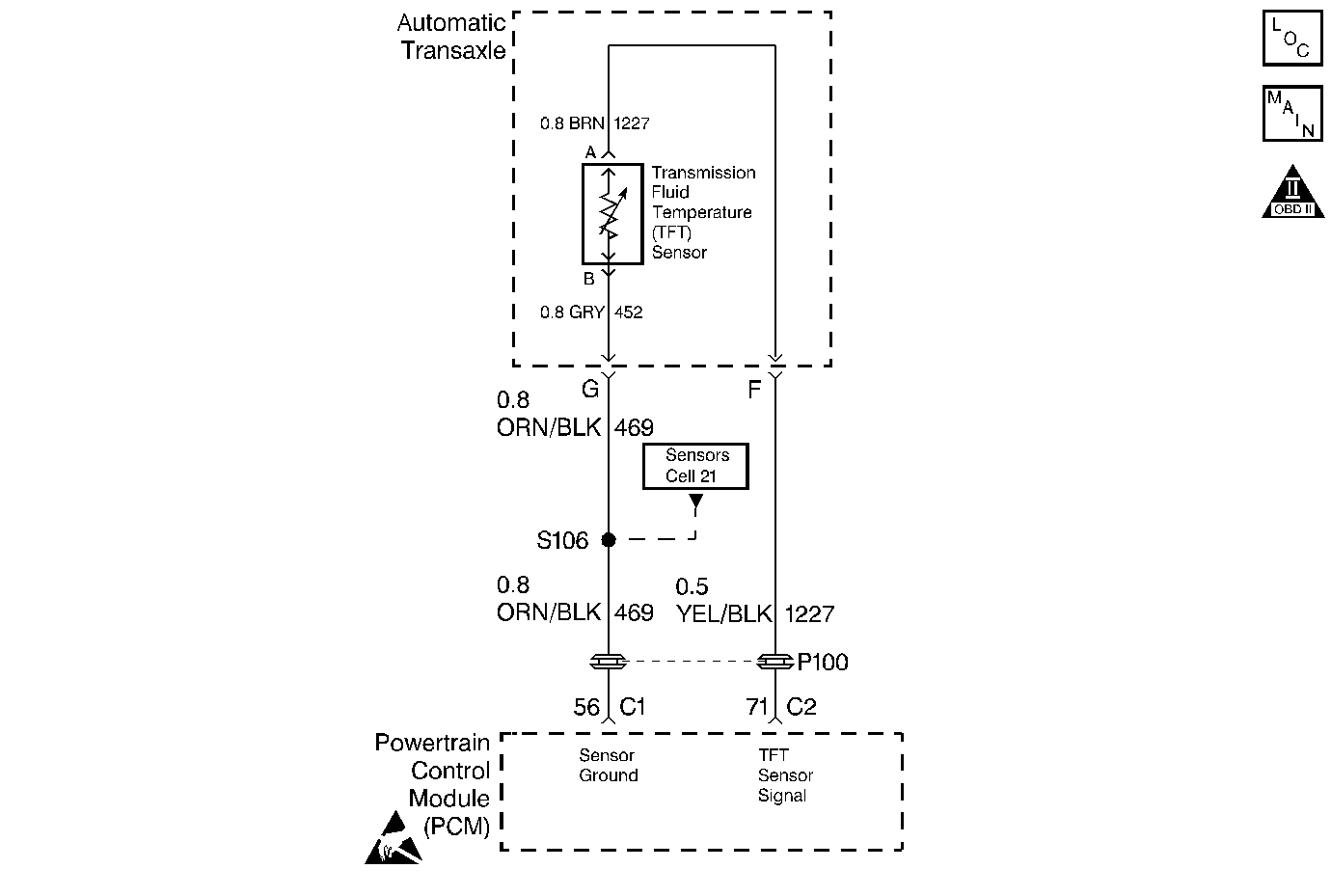
Circuit Description
The Automatic Transmission Fluid Temperature sensor is a negative coefficient thermistor. The sensor resistance changes with temperature. The Powertrain Control Module (PCM) provides a 5-volt reference to the sensor on circuit 1227. An open in circuit 1227 or circuit 469 results in high signal voltage. The TFT operating range is from -40 to +140°C (-40 to +284°F).
When the PCM detects a voltage input greater than 4.92 volts in the TFT Sensor circuit, then DTC P0713 sets. DTC P0713 is a type D DTC.
Conditions for Setting the DTC
| • | No System Voltage Malfunction DTC P0560 |
| • | The ignition is ON. |
| • | The PCM detects a transmission fluid temperature of -35°C (-31°F) or less (4.92 volts or more) for 7 minutes. |
Action Taken When the DTC Sets
| • | The PCM uses a default transmission fluid temperature of 95°C (203°F) for transmission operation. |
| • | The PCM does not illuminate the Malfunction Indicator Lamp (MIL). |
Conditions for Clearing the DTC
| • | A scan tool can clear the DTC from the PCM history. The PCM clears the DTC from the PCM history if the vehicle completes 40 warm-up cycles without a failure reported. |
| • | The PCM cancels the DTC default actions when the fault no longer exists and the ignition is OFF long enough in order to power down the PCM. |
Diagnostic Aids
| • | Inspect the wiring for poor electrical connections at the PCM. Inspect the wiring at the transmission 7-way connector. Look for the following conditions: |
| - | A bent terminal |
| - | A backed out terminal |
| - | A damaged terminal |
| - | Poor terminal tension |
| - | A chafed wire |
| - | A broken wire inside the insulation |
| • | When diagnosing for an intermittent short or open condition, massage the wiring harness while watching the test equipment for a change. |
| • | Inspect the transmission harness for a short to ground. Inspect the engine harness for a short to ground. |
| • | Inspect the transmission cooling system for blockage or other restrictions. |
| • | Refer to Temperature vs Resistance . |
Test Description
The numbers below refer to the step numbers on the diagnostic chart.
-
A scan tool Trans. Fluid Temp. of -36°C (-33°F) or less indicates that this DTC is current.
-
This step isolates the fault between the transmission harness or the engine harness. If the ignition is ON for more than 5 minutes, the PCM uses the default transmission temperature.
Step | Action | Value(s) | Yes | No | ||||||
|---|---|---|---|---|---|---|---|---|---|---|
1 | Was the Powertrain On-Board Diagnostic (OBD) System Check performed? | -- | ||||||||
2 | Perform the transmission fluid checking procedure. Refer to Transmission Fluid Check . Have you performed the procedure? | -- | Go to Transmission Fluid Check | |||||||
Important: Before clearing the DTCs, use the scan tool in order to record the Failure Records for reference. The Clear Info function will erase the data. Does the scan tool display an Automatic Transmission Fluid Temperature (TFT) less than the specified value? | -36°C (-33°F) | Go to Diagnostic Aids | ||||||||
Important: If the ignition is ON for more than 5 minutes, the PCM uses the default transmission temperature. Does the scan tool display a TFT greater than the specified value? | 138°C (280°F) | |||||||||
5 | Connect circuit 1227, terminal F to a known good ground. Does the scan tool display a TFT greater than the specified value? | 138°C (280°F) | ||||||||
6 | Inspect circuit 1227 of the engine harness for an open. Refer to Troubleshooting Procedures, Section 8. Did you find and correct a problem? | -- | ||||||||
7 | Inspect circuit 469 of the engine harness for an open. Refer to Troubleshooting Procedures, Section 8. Did you find and correct a problem? | -- | ||||||||
8 | Inspect transmission circuits 1227 and 469 for an open. Refer to Troubleshooting Procedures, Section 8. Did you find and correct a problem? | -- | ||||||||
9 | Replace the TFT Sensor. Refer to Automatic Transmission Fluid Temperature Sensor Replacement, in On-Vehicle Service. Is the replacement complete? | -- | -- | |||||||
10 |
Did you find and correct a problem? | -- | ||||||||
11 | Replace the PCM. Refer to Powertrain Control Module Replacement/Programming , Section 6. Is the replacement complete? | -- | -- | |||||||
12 | In order to verify your repair, perform the following procedure:
Has the test run and passed? | -- | System OK |
